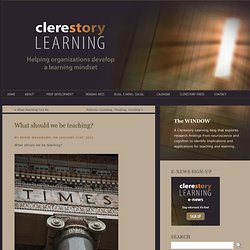

New ways to distribute content: part 1. Before Sir Tim Berners-Lee did us all a big favour some twenty years ago by inventing the World Wide Web, the distribution of content was a very physical process.

Regardless of the format – book, CD, DVD or whatever – some form of ‘master’ would be produced and this would be used as a basis for the manufacture of the finished goods. These would then be boxed up and physically distributed to wholesalers, retailers and eventually end customers. The books and CDs would end their journey neatly lined up on shelves or in racks, ready for consumption. How quaint this process is beginning to look come 2012. While there is still a market for ‘offline media’ (the sort you can use without an internet connection), it is fast dwindling. Learning content obeys the same rules. In the old world, learning content was a bit of an after-thought. With the shift from ‘courses’ to ‘resources,’ content becomes critical. Coming in part 2: Choosing a format for your content About Clive Shepherd. When an adult took standardized tests forced on kids - The Answer Sheet.
Update 12/12: QUIZ: Take part of the test that the local school board member took in the story below: Reading Quiz | Math Quiz.

Questions come from the Florida Comprehensive Assessment Test (FCAT) for 10th grade. Update 12/6: Revealed: The school board member who took standardized test Original post: This was written by Marion Brady, veteran teacher, administrator, curriculum designer and author. By Marion Brady A longtime friend on the school board of one of the largest school systems in America did something that few public servants are willing to do. By any reasonable measure, my friend is a success. He called me the morning he took the test to say he was sure he hadn’t done well, but had to wait for the results. “I won’t beat around the bush,” he wrote in an email. He continued, “It seems to me something is seriously wrong. “I have a wide circle of friends in various professions. Here’s the clincher in what he wrote: There you have it. But maybe there’s hope. What should we be teaching? By Kevin Washburn, on January 31st, 2012 What should we be teaching?

This question received significant attention at the November 2011 Learning and the Brain Conference in Boston. With the changes in our world and in our students, what should we, then, teach? The question reveals a consequential recognition: some of what we’ve taught and how we’ve been teaching it lacks relevance for today’s world and today’s learners. Specifically, several presenters suggested education’s over-reliance on questions that have one right answer may prevent teachers from emphasizing the content and skills that will benefit today’s students. Wagner’s “Survival Skills” What we should emphasize instead, according to Wagner, are seven “survival skills” that today’s students (and many of today’s working adults) need for thriving in an increasingly technological world. Critical thinking and problem solving.
It may be time for just such an examination. References Wagner, T. Image.